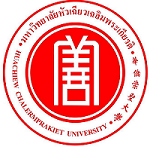Please use this identifier to cite or link to this item:
https://has.hcu.ac.th/jspui/handle/123456789/4268| Title: | Mechanisms of Vasorelaxation Induced by Hexahydrocurcuminin Isolated Rat Thoracic Aorta |
| Authors: | Aida Moohammadaree Chatchawan Changtam Piyawadee Wicha Apichart Suksamrarn Jiraporn Tocharus Chainarong Tocharus ไอดา มูฮำหมัดอารี ชัชวาลย์ ช่างทำ ปิยะวดี วิชา อภิชาต สุขสําราญ จิราภรณ์ โตจรัส ชัยณรงค์ โตจรัส Chiang Mai University. Faculty of Medicine Huachiew Chalermprakiet University. Faculty of Science and Technology Chiang Mai University. Faculty of Medicine Ramkhamhaeng University. Faculty of Science Chiang Mai University. Faculty of Medicine Chiang Mai University. Faculty of Medicine |
| Keywords: | Aorta ท่อเลือดแดง เอออร์ตา Endothelium เอนโดธีเลียม Hexahydrocurcumin เฮกซะไฮโดรเคอร์คูมิน Hypertension ความดันเลือดสูง Vasrelaxation ภาวะหลอดเลือดคลาย Curcuma longa L. ขมิ้นชัน Curcuminoid เคอร์คิวมินอยด์ |
| Issue Date: | 2015 |
| Citation: | Phytother Res 2015 Nov;29(11):1806-13. |
| Abstract: | This study was designed to examine the vasorelaxant effects of hexahydrocurcumin (HHC), one of the major natural metabolites of curcumin from Curcuma longa, on rat isolated aortic rings, and the underlying mechanisms. Isometric tension of the aortic rings was recorded using organ bath system. HHC (1 nM to 1 mM) relaxed the endothelium-intact aortic rings pre-contracted with PE and KCl in a concentration-dependent manner. Removal of the endothelium did not alter the effect of HHC-induced relaxation. In Ca(2+)-free Krebs solution, HHC significantly inhibited the CaCl2-induced contraction in high K(+) depolarized rings and suppressed the transient contraction induced by PE and caffeine in a concentration-dependent manner. HHC was also observed to relax phobal-12-myristate-13-acetate (PMA), an activator of protein kinase C (PKC), precontracted aortic rings in a concentration-dependent manner with EC50 values equivalent to 93.36 ± 1.03 μM. In addition, pre-incubation with propranolol (a β-adrenergic receptor blocker) significantly attenuated the HHC-induced vasorelaxation. These results suggest that the vasorelaxant effect of HHC is mediated by the endothelium-independent pathway, probably because of the inhibition of extracellular Ca(2+) influx through voltage-operated Ca(2+) channels and receptor-operated Ca(2+) channels, the inhibition of Ca(2+) mobilization from intracellular stores, as well as inhibition of PKC-mediated Ca(2+)-independent contraction. Moreover, HHC produces vasorelaxant effects probably by stimulating the β-adrenergic receptor. |
| Description: | สามารถเข้าถึงบทความฉบับเต็ม (Full Text) ได้ที่ : https://pubmed.ncbi.nlm.nih.gov/26360646/ |
| URI: | https://has.hcu.ac.th/jspui/handle/123456789/4268 |
| Appears in Collections: | Science and Technology - Articles Journals |
Files in This Item:
| File | Description | Size | Format | |
|---|---|---|---|---|
| Mechanisms-of-Vasorelaxation-Induced-by-Hexahydrocurcuminin-Isolated-Rat-Thoracic-Aorta.pdf | 68.01 kB | Adobe PDF | View/Open |
Items in DSpace are protected by copyright, with all rights reserved, unless otherwise indicated.
